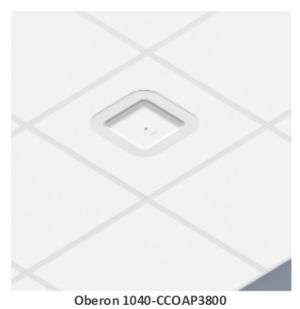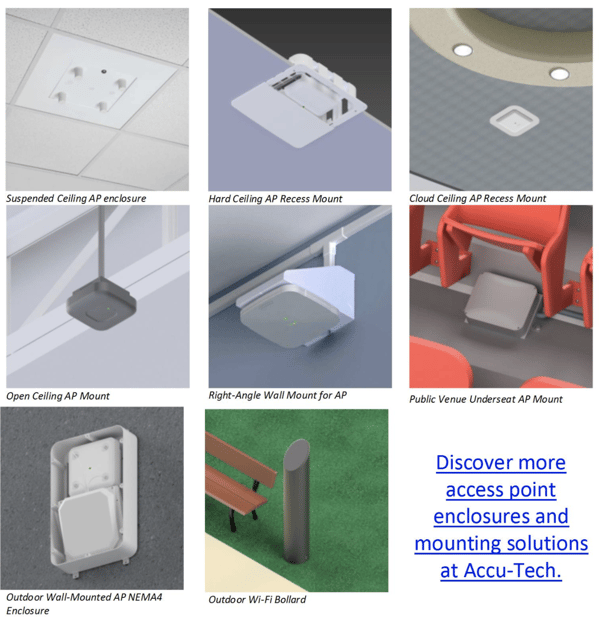 WiFi Access Points (APs) May Need to be Replaced Every Three to Five Years
WiFi Access Points (APs) May Need to be Replaced Every Three to Five Years
Access points need to be replaced more often than a lot of the other network infrastructure components. One reason is the advancement of wireless standards, based on improvement in technology and additional bandwidth. For example, in 2018, APs operating to the IEEE 802.11ac Wave 1 and Wave 2 standard are prevailing in new installs and replacing 802.11n APs. Why are APs replaced so frequently? Here are a few reasons:
- Newer standards provide for more antennas and radio transceivers to achieve higher throughput
- New wireless services are integrated into the APs, such as Bluetooth low energy (BLE)
- Additional radio channels become available, requiring either firmware or hardware upgrades
The WiFi APs Throughput Will Increase by a Factor of 10 Every Five to Seven Years
Of course, the primary reason to update and replace access points is to improve data throughput. The upward trend in throughput will certainly continue into the near future with the emergence of IEEE 802.11ax compliant access points operating in the 5 GHz band.
What is the impact of more advanced access points on the network? The Wireless Network Designer & Installer must consider the following:
- Data cabling rated to higher throughput speeds in Gbits/sec
- Potentially two cables run to each access point
- Switch port capability
- Over subscription rate assumptions on switching backbone
 Access Point Density Will Increase
Access Point Density Will Increase
Access point density will increase for a number of reasons:
- As the number of client devices and traffic increases, more APs are required to provide access
- APs operating on the 5 GHz band have a smaller zone of coverage (cell), versus a 2.4 GHz AP, so 5 GHz APs need to be closer together
- Wireless designers will use the smaller 5 GHz cell to reduce co-channel interference, thereby providing greater overall throughput
The WiFi Network Will Provide Additional Service
 The WiFi network will be required to support many new mobile applications, such as the following:
The WiFi network will be required to support many new mobile applications, such as the following:
- Voice over the WiFi (VoWiFi)
- 5G services
- First responder services (First Net in US)
- Real Time Location Services (RTLS)
- Wearable wireless services
- Patient monitors and Telemetry
- Asset management
Network PHY and MAC Standards Emerging
The wireless NDI will need to consider the emerging industry and IEEE standards as they relate to the cabling lant and switching network service on the wireless network:
- ANSI/BICSI 008-2018, WLAN Systems Design and Implementation Best Practices specifices that if balanced twisted-pair cabling is used, the cabling shall, at a minimum, meet Category 6A/Class EA performance. If optical fiber cabling is used, the cabling shall meet, at a minimum, OM3 performance.
- This document states that for future growth or technology changes, two horizontal links are recommended for each AP. Many access points have two data ports to provide for link aggregation, which is further rationale for two cables to each location.
- The use of a hybrid or composite optical fiber with copper conductors can be employed for extended distances, such as outdoor installations.
- The NBaseT standard provides for 2.5 Gb/s and 5 Gb/s Ethernet over existing (CAT5e or CAT6) cable plant. This will extend the useful life of some installed cabling infrastructure. More information is available on NBaseT here.
AP Power is Supplied by Power over Ethernet (PoE)
This trend to power access points with PoE has been ongoing for several years and will continue as standards evolve. APs will advance in capability and will require the power to support additional antenna and radio transceiver channels. The wireless NDI must consider the impact on the wired infrastructure and PoE switches and injectors.
- Installation Types and Mounting Solutions -
Different environments and construction types are present in all healthcare, education, commercial, government, retail, hospitality and industrial settings. How will access points be installed in suspended ceilings, hard ceilings, open ceilings, on walls, etc.? More importantly now than ever, how will the AP be installed in a manner that is aesthetically or architecturally suitable for the environment? Many building owners, architects, designers and installers are looking for ways to blend the AP into the venue in an aesthetically pleasing manner.
Consider the following installation types and the associated mounting solution, which can help to achieve a balance of performance, aesthetics and physical security.



.png?width=58&height=58&name=X_logo_2023_(white).png)
